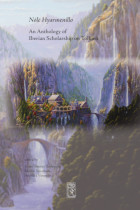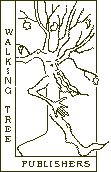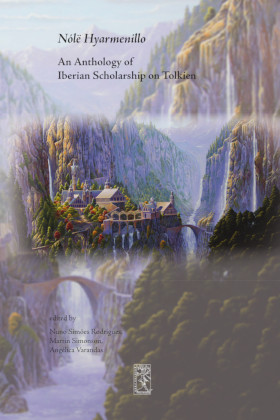Nólë Hyarmenillo An Anthology of Iberian Scholarship on Tolkien
Nuno Simões Rodrigues, Martin Simonson, Angélica Varandas (editors)
Cormarë Series No. 47

<--previous | all publications | next-->
how to buy this item
 The present collection, Nólë Hyarmenillo (‘Lore from the South' in Quenya), features essays written by Spanish and Portuguese scholars on diverse topics related to Tolkien and his legendarium, ranging from an analysis of film posters and adaptations, to studies of comparative literature, ecocritical analysis and the role and impact of Tolkien's works in contemporary subculture. As such, the anthology also reflects the growing bonds between two national communities of scholars, who over the past decade have consolidated research on Tolkien's legendarium at various large universities on the Iberian peninsula.
The present collection, Nólë Hyarmenillo (‘Lore from the South' in Quenya), features essays written by Spanish and Portuguese scholars on diverse topics related to Tolkien and his legendarium, ranging from an analysis of film posters and adaptations, to studies of comparative literature, ecocritical analysis and the role and impact of Tolkien's works in contemporary subculture. As such, the anthology also reflects the growing bonds between two national communities of scholars, who over the past decade have consolidated research on Tolkien's legendarium at various large universities on the Iberian peninsula.
table of contents | abstracts | cover | announcements | more

Miguel Moiteiro Marques
"I didnt see the films, but I read the posters"
(abstract)
Angélica Varandas
Facing Hope:
The Lord of the Rings, Beowulf and the Anglo-Saxon Elegiac Tradition
(abstract)
Ana Daniela Coelho
‘I See Fire': Adapting The Hobbit beyond the Image
(abstract)
Hélio Pires
Asgard and Valinor: Worlds in Comparison
(abstract)
Andoni Cossio
The Voice of Nature in Middle-earth through the Lens of Testimony
(abstract)
Martin Simonson
"Nonetheless They Will Have Need of Wood":
Aesthetic and Utilitarian Approaches to Trees
in The Silmarillion and Unfinished Tales
(abstract)
Alejandro Martínez-Sobrino
Boromir: a Character Doomed to Die
(abstract)
Mónica Sanz
Shadows of Middle-earth:
Tolkien in Subculture, Counterculture and Exploitation
(abstract)
Amaya Fernández Menicucci
"Aren't You Going to Search My Trousers?":
Gender and the Representation of the Dwarves in
Peter Jackson's Adaptation of J.R.R. Tolkien's The Hobbit
(abstract)
table of contents | abstracts | cover | announcements | more

Abstracts
PART I
"I didn't see the films, but I read the posters"
The success of the film trilogy The Lord of the Rings brought many people in contact with the world created by J.R.R. Tolkien. However, readers that knew the books and those that read the trilogy after watching the films could identify divergences in the narrative and in the role of the characters presented in each artistic creation. The same happens between the posters of the films and the films themselves. In this study, The Grammar of Visual Design proposed by Gunther Kress and Theo van Leeuwen (2006) is used to read the posters as multimodal texts. This approach allowed to identify divergences between the "narrative" of the posters and the ones presented in the films and the books. Furthermore, changes in the apparent status and role of the characters of the trilogy were also identified, which may reflect marketing strategies adapting the advertising of the films to the reactions of the audiences.
Key-words: multimodality; visual grammar; film adaptation; film poster; film advertising; Tolkien.
Facing Hope: The Lord of the Rings, Beowulf and the Anglo-Saxon Elegiac Tradition
J. R. R. Tolkien dedicated much of his academic thought to Beowulf, producing what still is the major innovative and ground-breaking essay on it – ‘Beowulf: The Monsters and the Critics', a 1936 text which utterly changed the under- standing of the poem, which he also translated into Modern English. Beowulf was likewise a main source of inspiration for his own legendarium, shaping many episodes and characters from The Hobbit and The Lord of the Rings. In this essay, we do not want to speak about specific episodes from The Hobbit or The Lord of the Rings influenced by Beowulf. Instead, we would like to focus how The Lord of the Rings parallels the Anglo-Saxon text in terms of what we consider one of its major themes: the cycle of life and the inevitability of death.
Key-words: elegy; Beowulf; Anglo-Saxons; The Lord of the Rings; On Fairy-stories.
‘I See Fire': Adapting The Hobbit beyond the Image
Music is a central element of film, and in the case of The Lord of the Rings (2001- 2003) and The Hobbit (2012-2014), it played a defining part in the shaping of Tolkien's adaptation to cinema. Nonetheless, attention to the soundtrack has often bypassed the pop songs released with each film of both trilogies. This chapter intends to analyse one of these songs, ‘I See Fire', by Ed Sheeran, released for the last but one of these films, The Desolation of Smaug (2013).
Key-words: soundtrack; adaptation; transmedia adaptation; The Hobbit; "I See Fire".
Asgard and Valinor: Worlds in Comparison
When creating his literary universe, Tolkien drew from the medieval sources of Norse mythology, so much so that, in the early versions of his work, Asgard features as an equivalent of Valinor. That could be seen as a simple sign of the author's process and goals, but there may be more to the equivalence than a mere generic correspondence. Indeed, a detailed analysis of the two divine worlds, comparing them side by side, suggests a deeper connection and, in the process, reveals a particular Eddic poem that, like Völuspá, may merit being singled out as one of Tolkien's sources.
Key-words: Asgard; Valinor; gods; divine residences; Grímnismál.
PART II
The Voice of Nature in Middle-earth through the Lens of Testimony
Some readers may consider sub-creation or secondary worlds as totally alien entities to the ‘Real World' despite the numerous parallels between these two dimensions. This paper aims to emphasize this connection by showing how a ‘real-life genre' such as testimony, composed of realistic features, can be employed in fantasy literature by means of an analysis of the character Treebeard, a tree-shepherd, and his testimony in J.R.R. Tolkien's The Lord of the Rings. In order to achieve that, the theoretical background of testimony will be explained (Dominick LaCapra, Giorgio Agamben, Hugo Achugar, Javier Sánchez Zapatero, Margaret Randall and Myriam Jimeno) alongside a process to detect and analyse the characteristics present in the narrative of Tolkien's literary work and sub-creation Arda. Primordially, testimony aims to give a voice to those who have been silenced by mainstream history, and Treebeard's testimony is the epitome of this. Testimony's main aim is to raise awareness of some up-until-then concealed perspective of a historical deed, but Treebeard goes a step further by becoming a rebel and leading a revolt against Saruman who is responsible for the wanton destruction of many trees. This unique testimony does not only represent an individual or a group of trees, but also nature as understood in the broad sense of the word, both in the world of Arda and the ‘Real World.'
Key-words: Treebeard; trauma; testimony; nature; ecocriticism; worldbuilding.
A common assumption about J.R.R. Tolkien's works is that they are escapist, only dealing obliquely with issues related to the real world. This claim has been contested in the field of literary studies by linking Tolkien's literary out- put with twentieth-century concerns such as modernist practices and, more recently, by ecocritical readings of his tales. However, scholars in the latter field, for instance Dickerson, Evans, and Campbell, frequently over-emphasize wonder and the spiritual connection with the natural world as the intended response of readers, which undermines the potential implications and relevance of Tolkien's works for tangible real-world issues. In this essay I wish to show that Tolkien's cosmological vision is not only premised on the idea of appreciating the wonder-inciting qualities of the world but that it also entails a certain amount of utilitarianism, and the need to combine both is related to the ethical theory of ideal utilitarianism as outlined by G.E. Moore. Moreover, in several early episodes of The Silmarillion, the combined approach to the natural world is represented by trees, setting a mythical precedent for later works. Of the latter, I will be looking mainly at ‘Aldarion and Erendis' in Unfinished Tales and ‘The Downfall of Númenor' in The Silmarillion.
Key-words: The Silmarillion; Unfinished Tales; ‘Aldarion and Erendis'; ‘The Downfall of Núúenor'; trees in literature
Boromir: a Character Doomed to Die
The following paper aims to analyse the ultimate causes behind Boromir's death. The perspective, following James Redfield's path in his Nature and Culture in the Iliad, will be that of the tragic hero. Boromir, like Hector in the Iliad, is a character unable to cope with the responsibilities and expectations imposed on him both by himself and his culture. Unable to solve the conflict between himself and his place in the story, Boromir ends up committing a mistake which will be the cause of his death, and this sets him off from the rest of the heroic characters in The Lord of the Rings.
Key-words: Boromir; Théoden; epic hero; tragic hero; hybrids; death; sacrifice.
Shadows of Middle-earth: Tolkien in Subculture, Counterculture and Exploitation
Tolkien's works have inspired many artists, who reflected their views on il- lustrations, music, cinema or comics. But they also have inspired unexplored niches of artistic realisations, their influence reaching even subcultural and countercultural movements.
Through Tolkien's personal view of applicability and his aim to leave in- spiration for other hands to complete his masterpieces, and by adopting a Cultural Studies perspective, this essay will take you on an unexpected jour- ney through lesser known cultural phenomena that resonate with Tolkien's works as inspiration, justification, appropriation or reflection. The results of such interactions may surprise you, as well as they could surprise Tolkien himself, but they prove to be worth the study as independent entities touched by the Professor's writings.
Key-words: cultural studies; subculture; counterculture; hippies; exploitation; graffiti; origami; drag; Campo Hobbit; porn.
In the present contribution, I intend to focus on the way in which the em- bodiment and performance of dwarvish masculinity/ies in Peter Jackson's adaptation of J.R.R. Tolkien's The Hobbit are designed to create three very distinctive narrative tones: comedic, romantic, and epic. Indeed, Jackson's configuration of the dwarves' physical appearance and behaviour spans from the grotesquely comical to the heroically tragic, and I contend that such configura- tion significantly contributes to turning Tolkien's adventurous novel for young readers into a filmic trilogy that aspires to encompass both the grandeur of an epic tale, and the emotional intensity of a love story. I will thus use Tolkien's representation of the dwarves as the control group against which to gauge the extent of Peter Jackson's departure from the hypotext, and to prove that, while the dwarves' appearance in general, and Kili's and Thorin's in particular can be seen as clearly citational in the Butlerian sense, it is not Tolkien's dwarves that are being referenced by either.
Key-words: The Hobbit; Peter Jackson; gender; masculinities; physical representation.
table of contents | abstracts | cover | announcements | more

Cover
Cover illustration Rivendel: el Refugio Élfico by Fredy Jaramillo
(click above view to enlarge)
table of contents | abstracts | cover | announcements | more

Announcements
Mythlore reviews Nólë Hyarmenillo (11th December 2023)
Eight book reviews (4th July 2023)
Article shortlisted for Tolkien Society Awards 2023 (31st March 2023)
Journal of Tolkien Research reviews Nólë Hyarmenillo (31st March 2023)
Beyond Bree reviews Nólë Hyarmenillo (10th February 2023)
New book: Nólë Hyarmenillo (23rd May 2022)

206 pages, Walking Tree Publishers 2022, Cormarë Series No. 47, Editor: Nuno Simões Rodrigues, Martin Simonson, Angélica Varandas
, ISBN: 978-3-905703-47-4.

<--previous | all publications | next-->
how to buy this item

More on Nólë Hyarmenillo An Anthology of Iberian Scholarship on Tolkien

terms and conditions
visitors since 21.05.22
last updated 21.05.22

